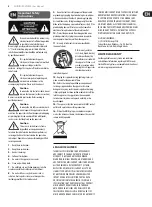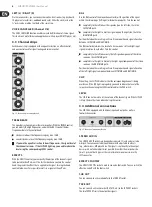
5
EUROPORT EPA900 User Manual
2.2 Setup
1. Separate the three pieces of the PA unit as described in Chapter 2.1.
2. Place the mixing console and loudspeakers in the required positions in
the venue.
◊
Use of the optional loudspeaker stands ensures a wider, more even
dispersion of sound.
3. Using the supplied cables, connect the loudspeakers to the rear
loudspeaker outputs.
!
!
Caution
ONLY connect the EPA900’s loudspeakers, never other equipment, via the rear
loudspeaker connectors. Otherwise, your equipment could get damaged.
4. Connect instruments, microphones, and additional equipment via the
remaining connectors on the mixer (see Chapter 4).
5. If you have an active subwoofer available (not included), connect it to the
SUB OUT socket.
6. Ensure that the two volume control knobs in the MAIN LEVEL CONTROL have
been turned counterclockwise as far as possible.
7. Use the IEC power cord to connect the mixer’s power inlet to an AC outlet.
8. Turn on the mixer.
9. Make the desired settings.
!
!
Caution
We would like to point out that high volume levels could damage your hearing.
Always make sure that the appropriate volume is set.
3. Control Elements and
Connections
The EPA900 mixer is equipped with 4 mono and 2 stereo inputs and an additional
AUX input. The input signals are internally distributed to a stereo bus. It is also
possible to use its channels separately (mono), such as when used for FOH/PA and
stage. Depending on the requirements, one stereo or two independent mono
sounds can be run. An internal effect can be used as an AUX effect from each
channel. The 7-band graphic equalizer is used to process the stereo bus or the
two mono paths.
3.1 Mono Channels (1-4)
Channels 1-4 are designed as mono channels and are used to connect
microphones or mono line-level sources. The connectors are balanced to
ensure high interference resistance. If possible, you should use balanced cable
connectors to profit from the advantages of this type of connection.
3.1.1 Microphone/Line Inputs
Fig. 3.1: Mono channel connectors
MIC
You can connect either dynamic microphones or condenser microphones to the
MIC connector using XLR plugs.
LINE IN
Via the LINE IN connector, you can connect instruments (e.g., keyboards,
electric guitars) or other line-level sources (e.g., CD player, external
mixers, notebook sound card). The ¼" jack accepts both balanced and
unbalanced connectors.
PAD
With the PAD switch, you can weaken loud input signals by 20 dB. Use this
function if the CLIP LED is lit up and the level cannot be reduced any further using
the LEVEL control.
PHANTOM
With the PHANTOM switch, you can activate the phantom power supply for all
microphone channels. Use the supply for condenser microphones.
3.2 Stereo Channels (5/6-7/8)
Channels 5/6-7/8 are designed as stereo channels and are used to connect stereo
line-level sources.
3.2.1 Line Inputs
Fig. 3.2: Stereo channel connectors
Summary of Contents for EPA900
Page 12: ...We Hear You ...






























